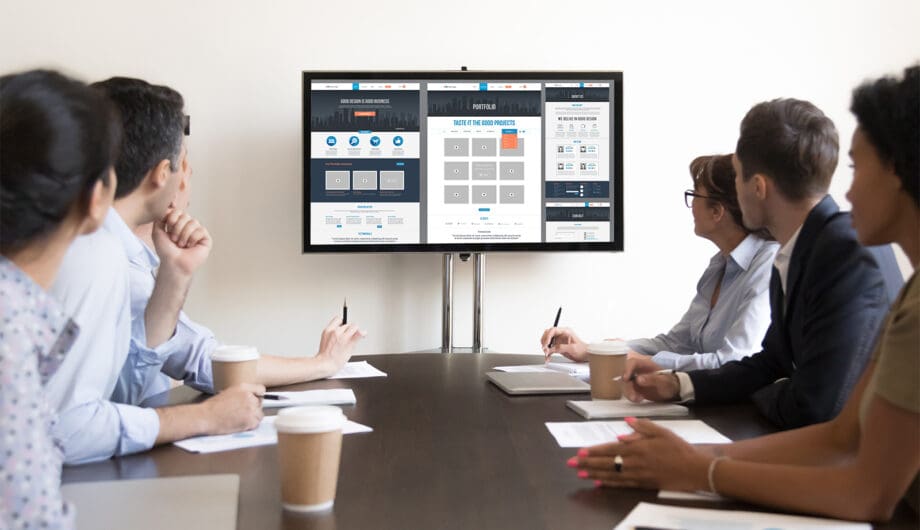
In the fast-paced digital era, a corporate website serves as the face of a business, often making the first impression on potential clients, partners, and employees. A well-designed corporate website not only communicates a brand’s identity but also plays a crucial role in establishing credibility and fostering trust. However, despite its significance, many businesses still fall victim to common mistakes in corporate website design that can hinder their online success. Here are my top 10 mistakes to avoid when you start working with a web design company on your corporate website.
1. Neglecting Mobile Responsiveness
Lots of people throw out stats about the percentage of people looking at websites on mobile, but most of those stats are misleading because this number changes depending on the industry. I was on a call with a client recently and I noted that their analytics indicated that over 80% of their traffic was coming via desktop user. They said that made sense, as most people looking for them are probably in an office during a workday. I had a client once tell me they believed 90% of their users were on mobile. When I looked at the data, it was actually 50%. The takeway here is that different target audiences have different technology uses, so no one stat is going to sum up how many people are looking at any one site on their phone.
However, just because you may know that 80% of your users are on desktop, that doesn’t mean you can ignore mobile. Neglecting mobile responsiveness is a big mistake when it comes to any website design, including corporate. A website that fails to adapt to various screen sizes and devices not only provides a poor user experience but also suffers in search engine rankings. Google gives preference to mobile-friendly websites and has for some time, making it essential for corporate sites to invest in responsive design.
A few mobile tips for your website:
- Less is more. It’s okay to have elements on your desktop website that don’t appear on your mobile display. I see this a lot when trying to convert desktop headers into mobile, so many buttons and things to click. Really simplify and think about what your mobile users want. Want to show four blog posts on your desktop view? Great! Maybe drop it to two for mobile users.
- Avoid popups. They can be hard to close on mobile for a lot of people.
- Make sure your font size is big enough to be read by anyone on a phone. Just because your viewport is smaller, doesn’t mean your font needs to get smaller.
- If you have e-commerce, please please please offer Apply Pay and Google Pay for your users to easily checkout on their phones. It’s not that hard and increases conversions!
2. Overlooking Page Loading Speed
In a world where attention spans are shrinking, the importance of fast-loading websites cannot be overstated. Users expect instant access to information, and a sluggish website can result in high bounce rates. Research indicates that a delay of just one second in page load time can lead to a significant drop in conversion rates.
To mitigate this mistake, optimize images, leverage browser caching, and invest in a reliable hosting provider. Compressing files, minimizing HTTP requests, and using content delivery networks (CDNs) are also effective strategies to enhance page loading speed. Regularly monitor and analyze your website’s performance to identify and address any speed-related issues promptly.
3. Poor Navigation and Information Architecture
A website’s navigation structure is like a roadmap for visitors, guiding them through the content seamlessly. However, poor navigation and information architecture can frustrate users and lead to high bounce rates. Common mistakes include complex menu structures, unclear labels, and a lack of logical organization.
To avoid this, keep menus simple and intuitive, ensuring that visitors can find the information they seek within a few clicks. Well-organized content not only improves user experience but also contributes to better SEO.
4. Ignoring Accessibility Standards
Web accessibility is not just a legal requirement; it is a moral imperative. Ignoring accessibility standards can exclude a significant portion of the audience, including people with disabilities. Inclusive design is crucial for ensuring that everyone, regardless of abilities or disabilities, can access and navigate your website.
To sidestep this mistake, adhere to established accessibility guidelines such as the Web Content Accessibility Guidelines (WCAG). Provide alternative text for images, ensure proper color contrast, and use semantic HTML to enhance screen reader compatibility. Regularly audit your website for accessibility issues and address them promptly to create an inclusive online environment.
One of my favorite ways to test is to turn off my mouse and try to navigate the website. Can I get to all the navigation items without a mouse? Do the drop downs work? (Common issue for keyboard navigation.)
A few accessibility tips:
- Remember that accessibility doesn’t just refer to users with visual impairments, it can include users with hearing impairment, color deficiencies, and physical/motor disabilities as well. Things you may not even think of, such as those who suffer from vertigo, can be triggered by certain things like parallax on a website. Make sure your videos are captioned, your colors are well contrasted, and your website can be navigated without a mouse.
- Alt text should be a description of your photo for people who can’t see the photo, not just a place to jam in your keywords. (You absolutely can and should include your keywords in alt text… just not to the exclusion of your description.)
- There are WordPress plugins to help with accessibility, but they are just tools to help you achieve a more accessible website, not a one and done fix. I like One Click Accessibility.
- User a Chrome extension like WAVE to test your site.
5. Complicated Forms and Calls to Action
Forms and calls to action (CTAs) are critical elements for converting visitors into leads or customers. However, complicated forms with excessive fields and unclear CTAs can deter users from completing desired actions. Users should be able to understand your forms and CTAs at a glance.
To avoid this mistake, streamline your forms by including only essential fields. Clearly label each field, use inline validation to provide real-time feedback, and consider implementing multi-step forms for lengthy processes. CTAs should be prominently displayed, use compelling language, and stand out visually. A clear and straightforward user journey encourages engagement and conversions.
6. Inconsistent Branding and Design Elements
A corporate website is an extension of a brand’s identity, and consistency is key. Inconsistent branding and design elements across the site can create confusion and dilute the brand’s image. This includes discrepancies in color schemes, typography, and overall design aesthetics.
To prevent this mistake, establish and adhere to brand guidelines from the outset of the design process. Ensure that your logo, colors, and typography are consistent across all pages. Consistency builds brand recognition and fosters a sense of trust among visitors. Regularly review your website to identify and address any deviations from your established brand guidelines.
7. Ignoring SEO Best Practices
Search engine optimization (SEO) is fundamental to a website’s visibility on search engines. Ignoring SEO best practices can result in poor search rankings, reducing the chances of your target audience discovering your website. Common mistakes include neglecting meta tags, ignoring keyword research, and overlooking the importance of quality content.
To avoid this mistake, conduct thorough keyword research to understand what terms your target audience is searching for. Optimize meta titles, descriptions, and header tags accordingly. Create high-quality, relevant content that provides value to your audience. Regularly monitor your website’s SEO performance, making adjustments as needed to stay competitive in search engine results.
We write about SEO a lot on this website. Check out our SEO articles.
8. Lack of Analytics and Data-driven Insights
Successful corporate website design goes beyond aesthetics; it requires continuous improvement based on data-driven insights. Failing to incorporate analytics and monitor user behavior can result in missed opportunities for optimization and growth.
To avoid this mistake, integrate Google Analytics from the start. Regularly analyze user behavior, track key performance indicators (KPIs), and gather insights into how visitors interact with your site. Use A/B testing to experiment with different design elements and functionalities, allowing data to guide decisions for ongoing improvement.
9. Unoptimized Images and Multimedia
Images and multimedia elements contribute to a visually appealing website, but their improper use can hinder performance. Large, unoptimized images can slow down page loading times, negatively impacting the user experience.
To prevent this mistake, optimize images before uploading them to your website. Use appropriate file formats (such as WebP for images) and compress files without compromising quality. Implement lazy loading for images and videos to prioritize the loading of visible content, deferring off-screen elements until needed. By optimizing multimedia elements, you enhance both performance and user satisfaction.
10. Not using professional photos
Building trust with your audience is one of the primary jobs of your website. Your corporate website shouldn’t be using photos taken with your phone in poor lighting. Your employees shouldn’t be providing their own photos for the website. TYour headshots and company photos should look good and be consistent. It’s worth the investment in a professional photographer to make your photos look great. Make sure you choose one that has good lighting equipment. Lots of photographers can take great photos outside, but your corporate photos probably need extra equipment to make them shine.
A reputable web design company can help you avoid a lot of these mistakes, but you still need to ask the questions, do the tests, and take the initiative to make sure none of these are overlooked. Need help with your corporate website design? Contact us today for a free quote.
Amy Masson
Amy is the co-owner, developer, and website strategist for Sumy Designs. She's been making websites with WordPress since 2006 and is passionate about making sure websites are as functional as they are beautiful.
